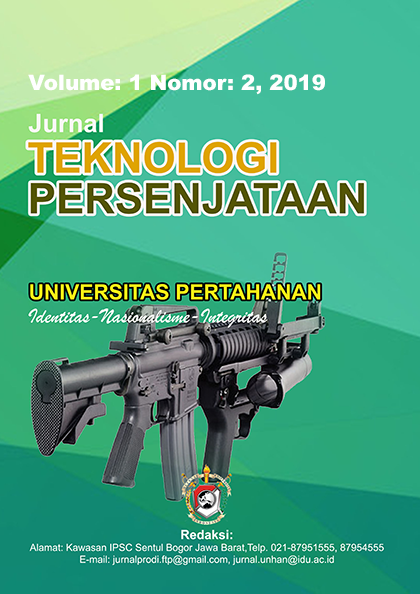DESAIN KENDARAAN MILITER DENGAN PENDEKATAN SYSTEM ENGINEERING
DOI:
https://doi.org/10.33172/tsj.v1i2.479Abstract
Menegangnya kawasan laut China Selatan menjadi urgensi pemerintah Indonesia dalam pertahanan maritim dan teritorial. Menjaga keamanan daerah yurisdiksi nasional laut Indonesia menjadi tugas dari pada TNI Aangkatan Laut, salahsatunya adalah upaya pertahanan pantai melalui komando utama satuan Korps Marinir, sebagaimana dalam misi tersebut diperlukan adanya satuan artileri sebagai pendukung operasi dan alutsista berupa system artillery yaitu Multiple Launch Rocket System yang bertugas memberi bantuan tembak pasukan terdepan, seiring berkembangnya kebutuhan dan ancaman yang berkembang sehingga dibutuhkannya suatu rancangan konseptual desain dalam pembuatan sistem ariteri Multiple Launch Rocket System sesuai kebutuhan Pemerintah dan TNI AL sebagai user, yang fokus terhadap sistem armamen, mobilitas dan launcher, seperti, pemilihan roket dan propellant yang sesuai dengan kebutuhan user. Engine, chassis serta trackling yang mampu menghasilkan manuver dan kemampuan lintas medan sesuai kebutuhan user. Serta sistem launcher yang terintegrasi dengan ground vehicle guna mendukung efisiensi waktu operasi dan presisi tembakan. Pada penelitian ini menggunakan metode Martin Maguire dan Nigel Bevan dalam pencarian kebutuhan pengguna menggunakan dengan pendekatan User requirement analysis untuk melakukan identifikasi kebutuhan pengguna, dan pendekatan sistem engineering Mohammad H. Sadrey dalam pembuatan rancangan konseptual desain, perhitungan dengan MDO (Multidisciplinary design optimization) menggunakan formula weighted-sum methode untuk mendapatkan kemungkinan konfigurasi dari variasi sub sistem yang telah diberi skor terhadap objective dan dilanjutkan mendapatkan konfigurasi optimum dengan Design Index Maximum, dimana dari hasil konfigurasi tersebut akan didapatkan sistem artileri yang sesuai dengan kebutuhan User.
Kata Kunci: Konseptual Desain, sistem artileri, Multiple Launch Rocket System, Pertahanan Pantai, MDO Multidisciplinary design optimization, Design Index, Design Requirement and Objective, System Engineering, User Requirement.
References
Buku
Arikunto, Suharsimi. 2010. Pengembangan Instrumen Penelitian dan Penilaian Program. Jakarta : Pustaka Pelajar
Kubota, Naminosuke. 2002. Propellants and Explosives – Thermochemistry and Combustion. WILEY-VCH : London
Pemda Kabupaten Natuna. 2014. Buku Putih Sanitasi Kabupaten Natuna. Riau : Pemda Natuna
Sadraey, Mohammad. 2013. Aircraft Design A Systems Engineering Approach. Wiley. United Kingdom.
Tyar, Semmy. Erlinda, E . 2017. TERBANG LANDAS JET TEMPUR KF-X/IF-X, Universitas Pertahanan. Bogor.
Yakti, Probo Darno. 2017. TNI Angkatan Laut sebagai World Class Navy pada Strategi Pertahanan dalam Mewujudkan Poros Maritim Dunia. Semarang : Gema Keadilan Universitas Diponegoro.
Jurnal
Characterisation of explosive weapons study. 2017. “Annex A – 122 mm BM-21 Multi Barrel Rocket Launcher”, Geneva International Centre for Humanitarian Demining (GICHD). Geneva
Maguire, Martin. Bevan, Nigel.2002.“User Requirements Analysis“. Proceedings of IFIP 17th World Computer Congress, Montreal, Canada.P133-148
Gustafsson, Tobias. Johansson, Anders. 2015. Comparison between Battery Electric Vehicles and Internal Combustion Engine Vehicles fueled by Electrofue” Department of Energy and Environment, CHALMERS UNIVERSITY OF TECHNOLOGY , Gothenburg, Sweden.
Artikel / Internet
Fadya, Aprilian. Pentingnya Pembangunan Pangkalan Militer Natuna. Dalam http://perpustakaan.bappenas.go.id/lontar/file?file=digital/163267-[_Konten_]-Pentingnya-Hen0001.pdf, di akses pada tanggal 19 oktober 2018
Downloads
Published
Issue
Section
License
Proposed Policy for Journals That Offer Open Access. Authors who publish with this journal agree to the following terms:
- Authors retain copyright and grant the journal right of first publication with the work simultaneously licensed under a Creative Commons Attribution License that allows others to share the work with an acknowledgment of the work's authorship and initial publication in this journal.
- Authors are able to enter into separate, additional contractual arrangements for the non-exclusive distribution of the journal's published version of the work (e.g., post it to an institutional repository or publish it in a book), with an acknowledgment of its initial publication in this journal.
- Authors are permitted and encouraged to post their work online (e.g., in institutional repositories or on their website) prior to and during the submission process, as it can lead to productive exchanges, as well as earlier and greater citation of published work (See The Effect of Open Access).
Proposed Policy for Journals That Offer Delayed Open Access. Authors who publish with this journal agree to the following terms:
- Authors retain copyright and grant the journal right of first publication, with the work [SPECIFY PERIOD OF TIME] after publication simultaneously licensed under a Creative Commons Attribution License that allows others to share the work with an acknowledgment of the work's authorship and initial publication in this journal.
- Authors are able to enter into separate, additional contractual arrangements for the non-exclusive distribution of the journal's published version of the work (e.g., post it to an institutional repository or publish it in a book), with an acknowledgment of its initial publication in this journal.

